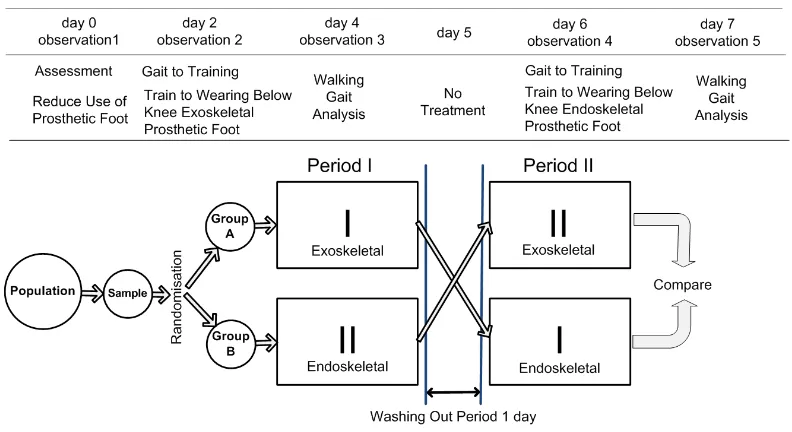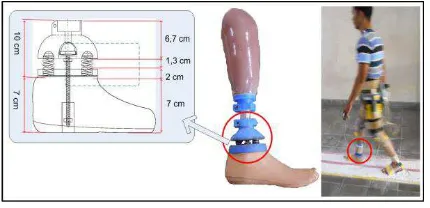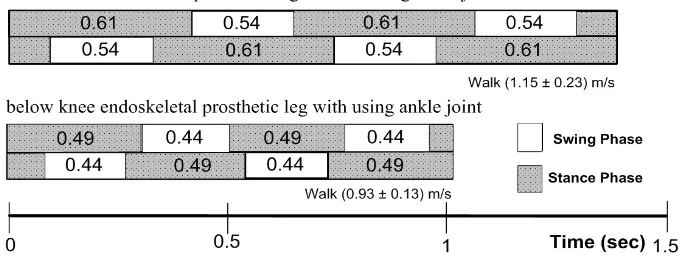2351-9789 © 2015 The Authors. Published by Elsevier B.V. This is an open access article under the CC BY-NC-ND license (http://creativecommons.org/licenses/by-nc-nd/4.0/).
Selection and Peer-review under responsibility of the Scientific Committee of MIMEC2015 doi: 10.1016/j.promfg.2015.07.073
Procedia Manufacturing 2 ( 2015 ) 413 – 418
ScienceDirect
2nd International Materials, Industrial, and Manufacturing Engineering Conference, MIMEC2015,
4-6 February 2015, Bali Indonesia
Step and Stride Length Characteristics of The Transtibial Amputee
Walking Gait for Using and without Using Functional
Ankle Joint Component
L. Herdiman
a*
,
N. Adiputra
b,
K. Tirtayasa
band I.B. Adnyana Manuaba
b aIndustrial Engineering Department, Sebelas Maret University Surakarta – Solo, Indonesia *Ergonomics Dept. of Postgraduate Program, School of Medicine, University of Udayana – Bali, Indonesia
b
Department of Physiology, School of Medicine, University of Udayana – Bali, Indonesia
Abstract
The application appropriate technology in the form of cosmetic and functional ankle joint for prosthetic leg user is equivalent to the K3 level which enables ambulation with variable cadence. The purpose of this study is to compare the gait characteristics between transtibial amputee when wearing endoskeletal prosthetic leg equipped with a multi-axis and energy store-return ankle joint technology and exoskeletal prosthetic leg without the technology during walking. A cross-over design study has been conducted towards the 14 transtibial amputees age 27.50 years (±7.37) and with body mass index 20.19 kg/m2 (±1.62). Gait characteristics are evaluated using a Digital SLR camera with 120 frames per second video recording. The measured gait parameters are include the time required during the stance phase and swing phase, right and left step, and stride length. There was a significant differences in gait characteristic of the amputee when using the endoskeletal prosthetic leg and the exoskeletal during stance and swing phase (p =0.015), step left (p = 0.025), step right (p < 0.0001) and stride length (p < 0.0001). The result is the using of endoskeletal prosthetic foot with the ankle joint technology can produce faster but more consistence movement for both normal and amputated leg.
© 2015 The Authors. Published by Elsevier B.V.
Selection and Peer-review under responsibility of the Scientific Committee of MIMEC2015.
Keywords: Transtibial amputee; ankle joint; gait characteritics; step length; stride length.
1.Introduction
The main objective of rehabilitation using prosthetics is to achieve functional capacity of amputated limb as close as possible to the limb before it was amputated. Unfortunately, the current achievement which is given to the
* Corresponding author. Tel.: +62-0271-632110; fax: +62-0271-632110. E-mail address:[email protected]
© 2015 The Authors. Published by Elsevier B.V. This is an open access article under the CC BY-NC-ND license (http://creativecommons.org/licenses/by-nc-nd/4.0/).
amputee is still unsatisfying. In general, cosmetics are still more prioritized than functionality. The difference approach is taken by developed and developing countries in term of the design and manufacturing criteria of prosthetic legs [1]. Given the consideration of the availability of materials, resources and skilled manufacturing operator, together with a variety of cultural differences make the world a prosthetic leg in developing countries is in it self [2]. Technology transfer from developed countries is useful only in the short term, but for the long run, it will not provide the maximum benefit given the amputee's ability to finance in general is very limited [3]. In Indonesia, prosthetic leg research has been conducted but it is still limited to the practical design thus the impact and benefit toward user has not been scientifically measured.
Prosthetic leg for developing countries should be designed as simple as possible [4], but it has a good functionality and cosmetic appearance which meet the amputee’s preferences. The most appropriate technology for the Indonesian is a technology that its implementation remains to consider several factors such as climate, topography, time and distance limitations amputee, psychological, and religious [5]. Most prostheses for transtibial amputations have three major parts: a socket; a shank, and a foot [6]. Since the current widely use Indonesian below knee prosthetic leg is exoskeletal type in which the ankle is fixed, the most feasible development to improve the capability of it is turning it into a flexible ankle joint or an articulation connection with the use of endoskeletal platform as its consequences. This component is a simple joint which connects the foot to the calf of the endoskeletal prosthetic foot but it play a very important role in providing foot flexibility during walking as an ankle of normal foot.
The application of appropriate technology in the design of the ankle joint components for below knee endoskeletal prosthetic leg refers to the seven criteria [7]. They are seven characteristics of appropriate technology that covers all aspects of the design: technically feasible, ergonomic, energy saving, economical, socio-culturally acceptable, environmental friendly, and trendy[8, 9]. Considering the people characteristic in developing countries, the main direction in determining the design component of the ankle joint for below knee endoskeletal prosthetic leg is not an sophisticated product. Of course the product should be functional but the more important things are to be low cost and easy maintenance.
The important things to ensure that the criteria used in designed the Indonesian prostheses are truly appropriate and useful for improving user’s life quality, it must be analyzed from the following aspects: technically, it is simple and low cost in the use and maintenance; economically advantageous (support productivity); scientifically proven in terms of health/ergonomics; socio-culturally acceptable (no strange look); have no contribution in environmental damage, energy saving (no external source would be the best), and still follow the technology trend for further development [10]. From these criteria, the embodiment of the design is not without any challenge. Selection of an appropriate prosthetic leg is complicated by a variety of foot design, performance-based marketing claims, and the limited availability of data to objectively compare the relative advantages and functional biomechanics of the different foot [11]. Nevertheless, all below knee amputation cases still require the use of a prosthetic [12].
This research approach is designing ankle joint with features that enable multi-axis articulation and dynamic response capability (energy store-return) [13], because most leg amputation cases have additional health problems that limit their ability to walk [14]. The design of the ankle joint through the application of appropriate technology is expected can comply with K3 level of lower limb amputation rehabilitation which potentially enables the amputee for ambulation with variable cadence [15]. This ankle joint design can be compared with previous systems such as flex-system mechanism foot, energy store-return, multi-axis, dynamic response which adopts flex-walk [16].
2.Method
The study was conducted using of a cross-over design which was approved by the Ethics Committee of Sebelas Maret of University Surakarta (protocol number: 638/XI/HREC/2014). The subjects was 14 transtibial amputee which divided into two groups (figure 1) : group A consists of 7 amputee which use exoskeletal prosthetic leg with fixed ankle, and group B consists of 7 amputee which use endoskeletal prosthetic leg with multi-axis and energy store-return ankle joint. After a washing out period, they are change the prosthesis type. For group A, the average age of them is 26.00 years (± 8.08), experience of wearing a prosthetic foot an average 6.00 years (± 6.53) and the average BMI of 20.31 kg/m² (± 1.27) while for group B, the average age of them is 29.00 years (± 6.9), experience of wearing a prosthetic foot an average of 10.29 years (± 6.13) and an average BMI of 20.08 kg/m2 (± 2.02). This research was conducted at the Laboratory of Movement Analysis in the Department of Industrial Engineering Sebelas Maret of University Surakarta.
Fig. 1. Schematic representation of an AB/BA crosses over design
The motion of the subjects was captured using a Canon EOS 1100D DSLR camera with 120 frames per second video recording and assisted with a Canon EF-S digital still camera 55-250 mm with a shutter speed of more than 1/4000 seconds and a JVC Everio camcorders camera GZ-MG760 video resolution of 640x480 pixels. Subject walk as far as 80 meters that do as much as 5 x repetitions with an average walking speed of 1.5 m/s for 6 minutes.
All statistical analysis was performed using the Statistical Package for the Social Sciences IBM SPSS version 20.0. To test the normality of the data the Shapiro-Wilk test and homogeneity of the data Levene’s test were used. Then, parametric tests (t-test) ware applied to the independent samples to compare the characteristics of the sample. The sample are data of time required during the stance and swing phase, left and right step length, stride length that all analyzed using 5% (p < 0.05) significance level.
3.Results and Discussion
Fig. 2. Ankle joint multi-axis with energy store-return
The bearing is supported by a shaft with Ø 10 mm rod end ball joint with height of 15 mm is attached with Ø 14 mm dome-shaped cavity is used to increase strength and reliability. For energy store-return capability, 4 pieces spring made of 2 mm carbon steel wire with a diameter of 19 mm and length of 3 mm are fitted in the lateral and medial sides of the ankle. In term of health/ergonomics, this design has equal weight and similar socket shape to the previous prosthesis type so it is still easy to can out of activities in daily living (ADL). Description of age, height and anthropometric characteristics of the study participants are presented in Table 1.
Table 1. Mean and standard deviation of anthropometric characteristics
Group A (n = 7) (BMI from 18.61 to 24.50 kg/m2)
Group B (n = 7)
(BMI from 19.34 to 22.39 kg/m2) p value*
Age (yrs) 29.00 ± 6.86 26.00 ± 8.08 1.000
Height (cm) 165.29 ± 5.94 162.14 ± 9.22 1.000
Estimation weight transtibial amputee (kg) 66.11 ± 9.37 65.93 ± 6.59 < 0.001
BMI (kg/m2) 20.08
± 2.02 20.31 ± 1.27 < 0.001
Experience wearing a prosthetic leg (yrs) 10.29 ± 6.13 6.00 ± 6.53 < 0.001
Length of leg stump (%) 29.15 ± 11.22 41.16 ± 16.30 < 0.001
Note: *p-value –student’s t-test (p < 0.05)
There were statistical differences in body mass between groups, whereas there was no statistically significant difference, indicating that BMI is strongly influenced by body mass. The variables analyzed in this study showed a statistically significant reduction (p < 0.05) in the transtibial amputee as shown in Table 2.
Table 2. Mean and standard deviation of the parameters gait
Group A (n = 7) (BMI from 18.61 to 24.50 kg/m2)
Group B (n = 7)
(BMI from 19.34 to 22.39 kg/m2) p value*
Time of stance phase (minute) 2.44 ± 0.50 1.97 ± 0.28 0.015
Time of swing phase (minute) 1.63 ± 0.33 1.31 ± 0.19 0.015
Step left length (cm) 20.16 ± 1.54 18.84 ± 0.88 0.025
Step right length (cm) 20.10 ± 0.67 18.37 ± 0.78 < 0.0001
Stride length (cm) 40.26 ± 1.83 37.21 ± 1.30 < 0.0001
Note: *p-value –student’s t-test (p < 0.05)
Fig. 3. Variation in gait cycle parameters with speed of movement
The amputee with below knee endoskeletal prosthetic leg can do faster swing phases with less effort which indicates the multi-axis and energy store-return of the ankle can reduce swing energy. In the other hand, stride length on exoskeletal prosthetic leg users are longer than the endoskeletal prosthetic leg user with average walking speed a bit faster (not significant) for the exoskeletal which show an overshoot as the effect of leg inertia after swing energy exerted by normal leg to the amputated leg with prosthesis. In other words, the endoskeletal prosthesis users seem more comfortable with more controllable step. As the result, the distance between the left and right step in endoskeletal looks more stable than exoskeletal prosthetic leg which indicates better equilibrium gait for endoskeletal prosthesis. This speed controlling ability is an important indicator for K3 level rehabilitation which assures that this appropriate technology performs better than the previous. Overall, the multi-axis with energy store-return for the ankle shows its functionality to improve the transtibial amputee walking gait.
4.Conclusion
The walking gait of transtibial amputee using multi-axis with energy store-return ankle joint on endoskeletal prosthetic leg shows more consistence step and stride length characteristic at almost similar walking speed than the exoskeletal which indicates better walking gait equilibrium.
References
[1] E. Strait, Prosthetics in Developing Countries, 2006.
[2] A. Bergsma, Lower Leg Prosthetics in Indonesia, 2014 or http://www.unescap.org/ESID/Meeting s/ICT09/Indo_P.pdf. accessed on 3 January 2015.
[3] B. Giesberts, A New Lower Leg Prosthesis for a Mobile Workshop in Indonesia, Assignment - Industrial Design Engineering, 2012. [4] J. Andrysek. Lower-Limb Prosthetic Technologies in The Developing World: A Review of Literature from 1994–2010. J. Prosthetics and
Orthotics International. 34 (2010) pp. 378–98
[5] D. Cummings, 1996. Prosthetics in the Developing World: A Review of The Literature. Journal of Prosthetics and Orthotics International. 20 (1996) 51-60.
[6] S.J. Garrison, (2003) Handbook of Physical Medicine and Rehabilitation Basics. Lippincott Williams & Wilkins Handbook Series. Philladelphia Publishing Inc. 24-6.
[7] I.B.A. Manuaba, Total Ergonomics Enhancing Productivity, Product Quality and Customer Satisfaction. Indonesian Journal of Ergonomics. 6 (2005) 1-6.
[8] I.B.A. Manuaba. Total Approach is a Must for Small and Medium Enterprises to Attain Sustainable Working Conditions and Environment, with Special Reference to Bali, Indonesia. Industrial Health Journal. 44 (2006) 22–6.
[9] Information on http://blog.isi-dps.ac.id/artayasa/ accessed on 3 January 2015.
[10] L. Herdiman, N. Adiputra, K. Tirtayasa, I.B.A. Manuaba. Designing a Low Cost Endoskeletal Below Knee Prostheses with The Implementation of Appropriate Technology. The International Conference on Green Design and Manufacture 2015. Surabaya. 31st July -
[11] J.A. Delisa, (2005) Physical Medicine & Rehabilitation Two-Volume Ses : Principles and Practice. Fourth Ed. Lippincott Williams & Wilkins Publisher. Philadelphia. 1330-3.
[12] D.E. Berens and R.O. Weed, (2010) Life Care Planning and Case Management Handbook, Third Edition, CRC Press, Taylor & Francis Group, Boca Raton. 321-34.
[13] K. Appleton, P. McAnally, The Steps Toward a Natural Gait: Energy Storage And Return Prosthetic Feet, University of Pittsburgh, Swanson School of Engineering, Session A1 #4011, 2014, 1-8.
[14] L.J. Marks, J.W. Michael, Artificial limbs, Clinical review, Science, Medicine and the Future, Jouran BM 323 (2001) 732-5.
[15] R.S. Gailey, K.E. Roach, E.B. Applegate, B. Cho, B. Cunniffe, S. Licht, M. Maguire, The Amputee Mobility Predictor: An Instrument to Assess Determinants of the Lower-Limb Amputee’s Ability to Ambulate, Arch Phys Med Rehabil, 83 (2002) 613-27.
[16] V. Agrawal, R. S. Gailey, I. A. Gaunaurd, C. O’Toole, A. Finnieston. Comparison Between Microprocessor-Controlled Ankle/Foot and Conventional Prosthetic Feet during Stair Negotiation in People with Unilateral Transtibial Amputation. Journal of Rehabilitation Research & Development. 50 (2013) 941-50.
[17] I.B.A. Manuaba, A Total Approach in Ergonomics is A Must to Attain Humane, Competitive and Sustainable Work Systems and Products, J. Human Ergol., 36(2007) 23-30.
[18] S. Lin and N.H. Bose, Six-Minute Walk Test in Persons with Transtibial Amputation, Journal Arch Phys Med Rehabil, 89(2008) 2354-9. [19] A.A. Linberg, K.E. Roach, S.M. Campbell, P.D. Stoneman, I.A. Gaunaurd, M.A. Raya, C.G. Orozco, R.S. Gailey, Comparison of


